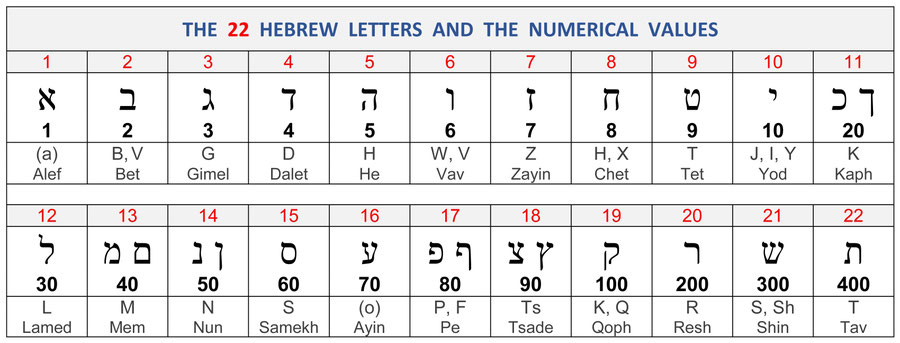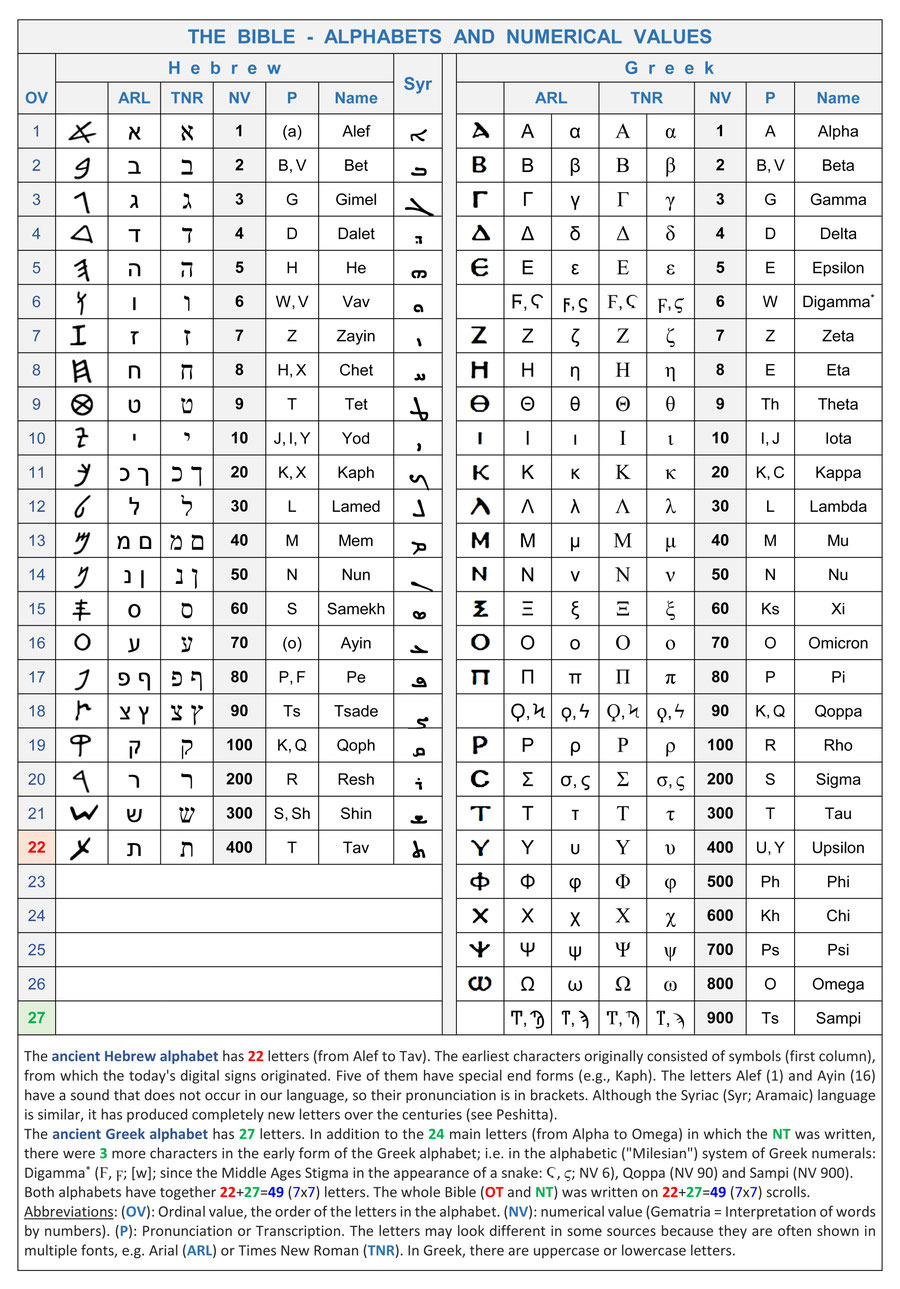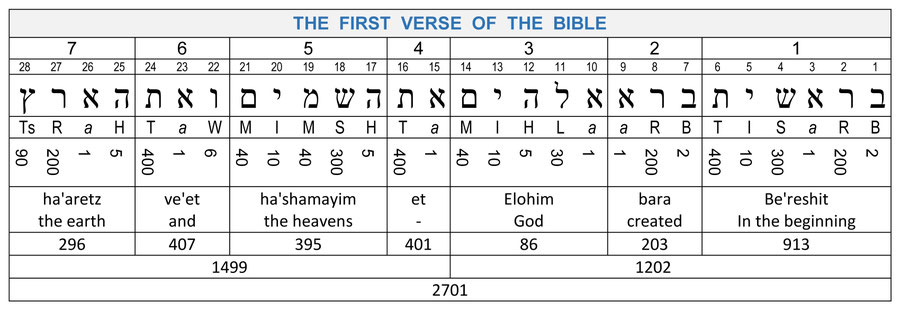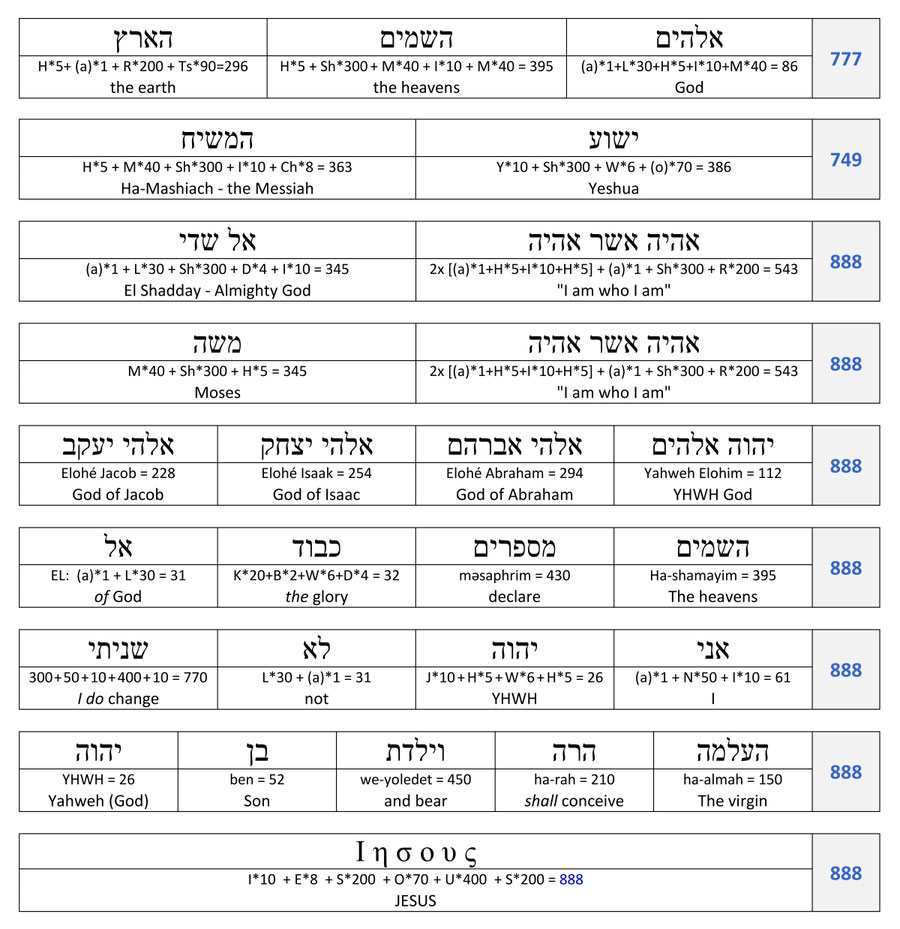The Old Hebrew alphabet has 22 letters and the ancient Greek alphabet 27 letters. Both alphabets have together 22+27=49 (7x7) letters. The whole Bible (OT and NT) was written on 22+27=49 (7x7) scrolls (see Structure of the Bible). The 7 is a sacred number and 7x7=49 means completeness and completion. The Old Hebrew and Old Greek languages had no special numbers. Therefore, numeric values have been assigned to all letters. In addition to the numerical values, the ordinal values are also distinguished. Ordinal values indicate the position of letters within the alphabet. Thus, each Hebrew and Greek letter and each word has a numerical and ordinal value. Every single word automatically has a specific number and ordinal value. Example: YHWH (Y*10 + H*5 + W*6 + H*5, ie 10-5-6-5) has the same number and ordinal 26, since the letters used do not have the 10th letter of the alphabet beyond which the numbers rise. But Jerusalem has the numerical value 586 (J*10 + R*200 + W*6 + Sh*300 + L*30 + M*40) and the ordinal value 82 (J*10 + R*20 + W*6 + Sh*21 + L*12 + M*13). If the numerical values of all 22 letters of the Hebrew alphabet are added together, the total value is 1495.
Gematria
Gematria are methods of assigning a numerical value to a name, word or phrase based on its letters. It means the interpretation of words with the help of numbers. It is also used in the Bible because God has encrypted additional information or details in certain names. Gematria was used in almost all ancient (Babylon, Greece, Rome...) and young cultures to detect hidden meanings. The most famous results (oder examples) of the Gematria are the numerical values 26 for Yahweh (YHWH), the 777 for the Hebrew words "God, the heavens, the earth" (see below), the 888 for Jesus (Greek Iesous) and 666 for the Antichrist (Rev 13:18; see calculation).
The Ancient Hebrew Alphabet
The ancient Hebrew alphabet has 22 letters (from Alef to Tav). The earliest characters originally consisted of symbols, from which the today's digital signs originated. 5 of them have special end forms (e.g., Kaph); together with the final characters there are 27 signs, but still 22 letters. The 6th letter Wav/Vav represents the consonant [w] in original Hebrew, and [v] in modern Hebrew; if there is a dot in front of or above the vav, it represents the vowels [u] or [o]. The letters Alef (1) and Ayin (16) have a sound that does not occur in our language, so their pronunciation is in brackets:
The 22 Hebrew letters look different in different fonts. Here's an example with Times New Roman and Arial (below). The upper number indicates the original values and the lower number indicates the numerical values:
It should be noted, however, that the Hebrew texts are not read from left to right, but from right to left. Although the Syriac (Syr; Aramaic) language is similar, it has produced completely new letters over the centuries (see Peshitta).
The Ancient Greek Alphabet
In its classical and modern forms, the alphabet has 24 letters, ordered from Alpha to Omega. However, the ancient Greek alphabet has 27 letters. In addition to the 24 main letters in which the NT was written, there were 3 more characters in the early form of the Greek alphabet; i.e. in the alphabetic ("Milesian") system of Greek numerals: Digamma* (Ϝ, ϝ; since the Middle Ages Stigma in the appearance of a snake: Ϛ, ϛ; NV 6), Qoppa (NV 90) and Sampi (NV 900). The following illustrations show the uppercase and lowercase Greek letters in the Times New Roman font and their numeric values:

The letters of the Bible and the numerical values
The numerical values of the Hebrew and Greek letters are no secret. They have been around for over 2000 years and have not changed. There are many literature sources (including Wikipedia) that correctly specify the numerical values of the letters. The following table gives an overview:
The calculation of numerical values is also important for Christians
God himself wants us to deal with numerical calculations. This will reveal additional information that was previously hidden. This requires wisdom and knowledge of the numerical values of the Hebrew and Greek letters. This is how the Antichrist will be revealed. We must first seek Jesus Christ and not the Antichrist. But if God himself gives us some information on this topic, then it is worth being watchful.
"Here is wisdom. Let him who has understanding calculate the number of the beast, for it is the number of a man: His number is 666" (Rev 13:18 NKJV).
The word used here for "calculate" means "to count with pebbles". In fact, Hebrews, Greeks, and Romans used letter-painted pebbles to calculate easier and faster (more info).
The Old Testament was written with 22letters. Some letters have a slightly different shape at the end of a word, but the numerical value does not change. The complete ancient Greek alphabet consists of 27 letters, but the NT was written with the 24 main letters. The letter Sigma has a different form within and at the end of a word.
Jesus means Love, Victory and Eternity - 888

The Greek name Iesous (Ιησους = Jesus) consists of 6 letters. The number 6 is the number of man, for Jesus was the Son of man. However, much more interesting is the numerical value 888, it means eternity and love.
The 888 is the number of eternity and perfection. It symbolizes victory over evil and eternal life. In the Hebrew language the word "to love" (ahab; Strong Nr. 157; Ex 20:6) has the numerical value 8, so the 888means "to love, to love and to love again." This is very understandable, because Jesus was love in person. There was no human being in the history of humanity who had as much love as Jesus. There is no other number that could better describe the name and character of Jesus than the 888,because it stands for eternity and total love. See calculation of the 888.

The first human was created on the 6th day and the 6 is the number of the human. Man lives in the world. The Greek name for the world is kosmos (κόσμος, Strong No. 2889) and has the numerical value 600.
The 888 (Jesus) came into the 600 (world) as a human being (6) to save us from eternal death and to free us from the power of 666 (evil; see more info about the calculation).
The first Vers of the Bible - 777
The Bible starts in the Hebrew text with 7words from 2x14=28 (=4x7) letters, the sum of which gives 2701 (37x73=2701). 37 and 73 are reflective numbers and the 12th and 21st prime, respectively. The numerical value for "the earth" (ha-aretz) is 296, which corresponds to 37x8=296. In the first sentence of the Bible, the 3 Hebrew words God, Heaven, and Earth give the sum of 777. The 777 is thus the Hebrew numerical value for creation (God, the heavens and the earth). This number represents the perfect, positive, perfect, peaceful and harmonious creation in God. The Hebrew text is read from right to left (Transliterated: Be-reshit bara Elohim et ha-shamayim ve'et ha'aretz):
The Numeric Value 888 in the Bible
The 888 is by no means just referring to the NT because there were numerous references to Jesus in the OT. The numerical values for "Almighty God" (El Shadday; Gen 17:1; 28:3; 35:11) and his own definition of "I am who I am" (“eh-yeh asher eh-yeh” Gen 3:14) give the value 888. The name "Moses" and "I am who I am" also give the 888, indicating that Jesus (the Word of God before becoming man) was the one who through Moses freed the people of Israel from the sin of Egypt. The apostle Paul refers specifically to this event when Moses went through the sea and makes it clear that the spiritual rock that followed the fathers was Jesus Christ (1Cor 10:1-5). The “God Yahweh” ("Jahweh Elohim"; Gen 2:4,5,7,8,9,15) is the “God of Abraham, God of Isaac, God of Jacob” (“Elohé Abraham, Elohé Isaak, Elohé Jacob”; Ex 3:6), all words added together give the number 888. In Psalm 19:1 the words "the heavens declare the glory of God" add up to the number888, because the heavens indeed declare the glory of Jesus Christ. Malachi 3:6 shows that in the sentence "I, the LORD, do not change" the number 888 appears. Even the unabridged word sequence of Isaiah 7:14 “the virgin shall became pregnant and bear a son” (“ha-almah ha-rah we-yoledet ben”) together with the word “Yahweh" (YHWH), gives the sum 888. Thus there was a prophetic indication in the OT as to what numerical value the name of the Messiah would have. In the Greek language, the name Jesus has the numeric value of 888. Jesus was love in person, and at the same time he was the savior of humanity, therefore he is above the 777 (the creation). His name stands symbolically above all other names by the 888, because he not only symbolizes eternity, but also love, salvation, victory, peace and harmony for all time. The text is read from right to left:
Jesus - The Messiah
The Greek name Iesous (Ιησούς = Jesus) has the numerical value 888. However, this name is not an original Greek name, but derives from the Hebrew. The Hebrew name Yeshua comes in 3 variations with 3 numeric values. In the first books of the OT, mostly one of the two long versions Yehoshua (mostly NV 391 and rarely NV 397) was needed. But after the Babylonian exile, the short form of Yeshua (NV 386), which we find in the books of the chronicles, as well as Ezra and Nehemiah, was usually used. This was a very common personal name, which is also documented in numerous inscriptions. Yehoshua (or Yoshua) appears exactly 27 times in the Torah (Ex 17:9,10,13,14; 24:13; 32:17; 33:11; Lev 11:28; 13:16; 14:6,30,38; 26:65; 27:18,22; 32:12,28; 34:17; Dt 1:38; 3:21,28; 31:3,7,14(2x),23; 34:9). The name JESUS is thus nothing but the Greek or English equivalent of the Hebrew Yehoshua and/or the short version Joshua. It is the same name only in different languages. The Hebrew word for “Messiah” (Mashiach or Mashiah; 1Sam 24:6.10) has the numerical value 358 and “The Mashiach” (HaMashiach; Lev 4:5,16; 6:22) 363. The specific expression, "Yeshua HaMashiach" (lit. "Jesus the Messiah"), does not occur in the Tanakh. In Christianity, “the Messiah” is called “the Christ” (from Greek: χριστός, Khristós) translating the Hebrew word of the same meaning. The concept of the Messiah in Christianity originated from the Messiah in Judaism. However, unlike the concept of the Messiah in Judaism and Islam, the Messiah in Christianity is the Son of God.
"Yeshua HaMashiach" in the Hebrew language is nothing other than "Jesus Christ" in the English and Greek (Ιησους Χριστος; Iesous Khristos) language. It is interesting to see how the Greek NT was translated into Hebrew. It becomes clear that the Hebrew short version "Yeshua HaMashiach" with the numerical value 749 was mostly used for "Jesus Christ". As an example serve the translation of Delitzsch 1886 and Modern Hebrew on Biblehub.com: Link
Example (Mt 1:1): "This is the genealogy of Jesus the Messiah" = Yeshua HaMashiach (NV 749) = ישוע המשיח
There are a lot more numerical values of words from the OT and NT with clear statements.















No comments:
Post a Comment